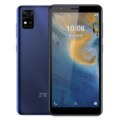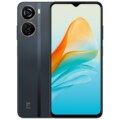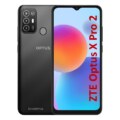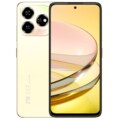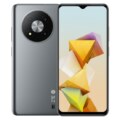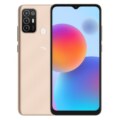- DroidAfrica
- Gadgets
- ZTE
- ZTE Axon 10 Pro 5G
ZTE Axon 10 Pro 5G

ZTE Axon 10 Pro 5G Highlights and Overview
The ZTE Axon 10 Pro 5G is the higher variant of the Axon 10 Pro, and just like the Axon 10 Pro, this unit comes with Qualcomm Snapdragon 855 CPU, 6.47-inch Full-HD+ display, and topping it all is native support for 5G network modem.
Aside the added support for 5G network bands, every other specs and features remains same; you are still getting the 6.47-inch Full-HD+ AMOLED display with waterdrop notch, has 6GB of RAM and runs Android Pie out of the box.
There is a 48-megapixel rear camera, along with a 20-megapixel 125° ultra-wide-angle lens and an 8-megapixel telephoto lens. There is also a 20-megapixel camera on the front.
It has an in-display fingerprint sensor and packs a 4000mAh battery with support for fast charging as well as wireless charging.Other specifications and silent features of the ZTE Axon 10 Pro 5G are detailed in the specification table below.
ZTE Axon 10 Pro 5G Full Specifications and Features
NETWORK
| Technology | GSM / HSPA / LTE / 5G |
| 2G Network Bands |
GSM 850 / 900 / 1800 / 1900 - SIM 1 & SIM 2 (dual-SIM model only) CDMA 800 & TD-SCDMA |
| 3G Network Bands |
HSDPA 850 / 900 / 1900 / 2100 CDMA2000 1xEV-DO |
| 4G Network Bands | LTE band 1(2100), 2(1900), 3(1800), 4(1700/2100), 5(850), 7(2600), 8(900), 20(800), 28(700), 38(2600), 39(1900), 40(2300), 41(2500) |
| Speed | HSPA 42.2/5.76 Mbps, LTE-A (3CA) Cat9 450/50 Mbps/5G |
LAUNCH
| Also Known As |
- - |
BODY
| Dimensions | 159.2 x 73.4 x 7.9 mm (6.27 x 2.89 x 0.31 in) |
| Weight | 175 g (6.17 oz) |
| Build | Back glass (Gorilla Glass 5), aluminum frame (7000 series) |
| SIM Type | Dual SIM (Nano-SIM, dual stand-by) |
DISPLAY
| Display Type | Super AMOLED capacitive touchscreen, 16M colors |
| Size | 6.47 inches, 102.8 cm2 (~87.9% screen-to-body ratio) |
| Resolution | 1080 x 2340 pixels, 19.5:9 ratio (~398 ppi density) |
PLATFORM
| Operating System | Android 9.0 (Pie); MiFavor 9.1 |
| Chipset | Qualcomm SDM855 Snapdragon 855 (7 nm) |
| CPU | Octa-core (1x2.84 GHz Kryo 485 & 3x2.42 GHz Kryo 485 & 4x1.8 GHz Kryo 485) |
| GPU | Qualcomm Adreno 640 |
MEMORY
| RAM + ROM | 6/8/12 GB |
| Card Slot | Yes, up to 256 GB via microSD card (uses SIM 2 slot) |
MAIN CAMERA
| Camera Type | Triple Lenses |
| Camera Sensor(s) | 48MP + 8 MP + 20 MP main camera |
| Camera Features |
Autofocus Continuous shooting Digital zoom Optical zoom Digital image stabilization Geotagging Panorama HDR Touch focus Face detection White balance settings ISO settings Exposure compensation Self-timer Scene mode Macro mode RAW Sensor size - 1/2" Pixel size - 1.6 μm (4-in-1 pixel binning) Phase detection Laser autofocus Contrast autofocus Sapphire crystal glass lens cover 6-element lens Focal length (35 mm equivalent) - 27 mm 1080p @ 960 fps 720p @ 960 fps Secondary rear camera - 8 MP (telephoto) Sensor model - Samsung S5K3M5 (#2) Sensor type - ISOCELL (#2) Sensor size - 1/3.4" (#2) Pixel size - 1.0 μm (#2) Aperture size - f/2.2 (#2) 6-element lens (#2) Focal length (35 mm equivalent) - 51 mm (#2) Third rear camera - 20 MP (ultra-wide angle) Sensor model - Sony IMX481 Exmor RS (#3) Sensor size - 1/3" (#3) Pixel size - 1.0 μm (#3) Aperture size - f/2.2 (#3) 6-element lens (#3) Focal length (35 mm equivalent) - 17 mm (#3) Angle of view - 117° (#3) |
| Video Resolution | 2160p@30/60fps, 1080p@30/120/240fps, 1080p@960fps |
SELFIE CAMERA
| Camera Type | Single Lens |
| Camera Sensor(s) | 20-megapixel |
| Camera Features |
f/2.0 aperture 1/4" Pixel Size, 1.0µm, Autofocus |
| Video Resolution | 1080p@30fps |
SOUND
| Loudspeaker | Yes |
| Speaker Location | Chin, below display |
| Audio Jack Type | No. Uses USB Type-C Connector |
CONNECTIVITY
| Bluetooth | Bluetooth 5.0, A2DP, LE, aptX HD |
| NFC | |
| GPS | Yes, with dual-band A-GPS, GLONASS, BDS, GALILEO, QZSS |
| FM Radio | No |
BATTERY
| Battery Capacity | Non-removable Li-Po 4000 mAh battery |
| Wireless Charging | Yes, Fast wireless charging |
| Talk Time Talk Time is the longest time that a single battery charge will last when you are constantly talking on the phone under perfect conditions, Ambient temperature and highly dependent on the cellular network environment such as the distance to the closest cell network tower. | Up to 24 hours |
| Stand-by | Up to 380 hours |
OTHER FEATURES
| Sensors | Fingerprint (side-mounted), accelerometer, proximity, compass |
| Box Contents | Charging Brick / USB cable |
ZTE Axon 10 Pro 5G User Reviews and Opinions
Disclaimer Note
We CANNOT guarantee 100% accuracy for the specification table above.

